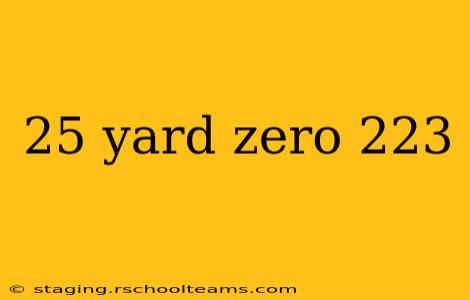The 223 Remington, a popular cartridge for both hunting and sport shooting, offers exceptional accuracy at various ranges. However, truly understanding its capabilities starts with mastering the fundamentals at close range. This article focuses on achieving a "25-yard zero" with your 223 Remington, explaining the process, the benefits, and crucial considerations for optimal performance.
Understanding the 25-Yard Zero
A 25-yard zero refers to the point where your rifle's bullet impacts the target at the same point of aim at both 25 yards and a longer distance (typically around 200-300 yards, depending on your ammo and rifle). This is achieved through careful sight adjustments. It's a popular choice for many shooters because it provides a relatively flat trajectory, meaning less holdover or hold-under is required for shots within a practical engagement range. While some prefer a 100-yard zero, the 25-yard zero often proves more advantageous for shorter-range shooting scenarios.
Benefits of a 25-Yard Zero:
- Reduced Holdover/Hold-under at Common Ranges: For targets within approximately 100 yards, you'll need minimal adjustments to your aim. This is especially valuable in dynamic shooting situations where quick reactions are critical.
- Faster Target Acquisition: Less time spent calculating trajectory translates to faster target acquisition and improved accuracy under pressure.
- Improved Accuracy at Close Range: The 25-yard zero ensures pinpoint accuracy within the most common engagement ranges for many 223 Remington users.
Zeroing Your 223 Remington at 25 Yards: A Step-by-Step Guide
Zeroing your rifle requires careful attention to detail and a methodical approach. Here's how to achieve a 25-yard zero for your 223:
-
Prepare Your Equipment: Ensure you have a stable shooting rest, a clear target at 25 yards, quality ammunition appropriate for your rifle, and necessary safety gear (eye and ear protection). A spotting scope will be invaluable.
-
Initial Sight Adjustment: Start by adjusting your sights (iron sights or scope) to a point you believe will be close to zero. This may involve using your knowledge of your rifle or starting with a general estimate based on your rifle's manual or online resources.
-
Fire a Three-Shot Group: Fire three shots from a stable position, noting the point of impact on your target.
-
Adjust Your Sights: Based on the point of impact relative to your point of aim, adjust your sights accordingly. Make small adjustments, as it's far easier to make several small adjustments than to correct one large mistake. Remember to check your adjustment methods based on your rifle's sight type. Consult your rifle's manual if you are unsure.
-
Repeat Steps 3 and 4: Continue this process until your three-shot group is centered on your target. Remember, consistency is crucial, so focus on maintaining a consistent shooting position and technique.
-
Verify at a Longer Range: Once you have a satisfactory group at 25 yards, verify the zero at a longer range (typically 200-300 yards, but this can vary depending on your chosen ammunition). You might need minor adjustments after this.
Factors Affecting Your 25-Yard Zero:
- Ammunition: Different ammunition types (brand, bullet weight, powder charge) will affect your trajectory. Choosing a quality, consistent ammunition is paramount.
- Rifle Condition: A well-maintained rifle will generally offer better accuracy and consistency.
- Shooting Technique: A consistent and proper shooting technique is essential for achieving accurate and repeatable results.
- Environmental Conditions: Wind, temperature, and humidity can all affect the bullet's trajectory.
Conclusion:
Achieving a 25-yard zero with your 223 Remington provides several advantages, particularly for close-range shooting. By following the steps outlined above and paying close attention to the influencing factors, you can effectively zero your rifle and improve your accuracy and confidence. Remember safety first, always practice responsible gun ownership, and enjoy the process of improving your shooting skills.
